-
Categories
-
Pharmaceutical Intermediates
-
Active Pharmaceutical Ingredients
-
Food Additives
- Industrial Coatings
- Agrochemicals
- Dyes and Pigments
- Surfactant
- Flavors and Fragrances
- Chemical Reagents
- Catalyst and Auxiliary
- Natural Products
- Inorganic Chemistry
-
Organic Chemistry
-
Biochemical Engineering
- Analytical Chemistry
-
Cosmetic Ingredient
- Water Treatment Chemical
-
Pharmaceutical Intermediates
Promotion
ECHEMI Mall
Wholesale
Weekly Price
Exhibition
News
-
Trade Service
(1) Basic principles and requirements to be mastered in rapid detection technology
1.
Fast food safety detection technology is required to ensure that the detection quality method is mature and stable, with high precision, accuracy and good selectivity, so as to ensure the scientificity, credibility and repeatability of the experimental data and conclusions
2.
It is required that the methods used in food safety rapid detection technology cannot cause harm to operators and environmental pollution
3.
The purpose of rapid food safety testing is mostly on-site rapid testing or screening of a large number of samples, which requires fast food safety testing technology to use inspection methods with fast response speed and high detection efficiency
4.
(1) A blank test must be done during inspection.
(2) Parallel test must be done during inspection
(3) A positive result should be confirmed because most of the rapid detection methods are qualitative or semi-quantitative tests, so when the test result is positive, quantitative methods should be used to confirm
5.
For the same test item, if there are two or more test methods, they can be selected and used according to different conditions
Rapid food inspection is a highly professional job, requiring inspectors to have both strong on-site disposal capabilities and on-site rapid inspection capabilities
Related links: The development trend of food rapid detection technology







